Being in Bordeaux’s wine regions in the height of summer was spectacular. The intensity of dense, green vines creates a wealth of anticipation for what this year’s harvest will bring. It’s far from the parched, summer fields where the crops have been harvested and all that remains is the chard. These ripening grapes will stay on the vines well into the autumn before the leaves change colour and the fruit is harvested.

We loved exploring Bordeaux’s wine regions.
Accommodation – Chateau Fage
To explore Bordeaux’s wine regions, we based ourselves at Chateau Fage, a 26 bedroom chateau, in the countryside about half way between Bordeaux and Saint Emilion. The original 19th century mansion is surrounded by 45 hectares of vineyards, meadows and forests.

Chateau Fage.
The property has undergone a significant renovation and is now a mix of the new and the old. The original chateau, is flanked with new bedroom wings, a grand dining room and a lovely, large swimming pool overlooking the estate.

Tim taking a dip in Chateau Fage’s pool.

Outdoor seating at Chateau Fage.
We enjoyed staying at the spacious property, except for two things. There was no laundry service, not ideal if you were there for five days as we were. In addition, they are very proud of their restaurant, La Maison des Vignes. However, due to staffing issues it was closed on Sunday and Monday, and they served a very average dinner buffet on Tuesday night. But the good news was, in the small town of Saint Germain-du-Puch, just five minutes away, was a restaurant, La Atmosphere. It was well patronised by locals and the food was good, much of it cooked on an open fire.

When the restauarnt at Chateau Fage, was open, the food was excellent.
Our best finds in Bordeaux’s wine regions
1. Saint-Emilion
Saint-Emilion is Bordeaux’s most beautiful village. It’s a charming medieval village located in the heart of Bordeaux’s wine area. It’s beautiful architecture, great monuments and wine make it a very desirable location to visit.
The region is famous for the Merlot grape which makes up about two-thirds of plantings in the areas. Merlot, when partnered with a little Cabernet Franc, to add seasoning and spice, produces a hearty wine, with dense colour and very soft on the palate- my favourite.

Tim loves a good wine shop.
Saint Emilion got its name from a monk from Brittany, Emilion. He fled his hometown, to seek refuge in one of the natural caves in the 8th century. Living the life of a hermit he was credited with a few miracles and rapidly became famous. With the help of his disciples they evangelized that place and it became a religious centre. After his death they named the town, Saint-Emilion.
The town acquired wealth and prominence from its wine production and a number of religious monuments were established, including Saint-Emilion’s underground Monolithic Church. The church was dug out from a large block of stone, in the 12th century. It’s of gigantic proportions and is well worth visiting. Tours are frequent, and are about an hour long.

Th entrance to the Monolithic Church in Saint Emilion.
Saint-Emilion, including the Monolithic Church, was added to the UNESCO World Heritage List in 1999.
2. Le Clos Mirande

Our lunch in the garden at Le Clos Mirande was excellent.
On a recommendation from wine merchant and friend, Jean-Christophe from Maison Vauron in Auckland, we went to Le Clos Mirande for Sunday lunch. We opted to sit outside in the beautiful garden. The service, the care with which the table had been set, and delicious food, all added to a delightful afternoon.

Meaty frogs legs were on the menu.
3. Chateau La Dominique for wine tasting and great food.
Jean-Christophe also recommended a wine tasting and lunch Chateau La Dominique, one of several vineyards owned by the Fayat family.
The wine tasting was excellent, and we sampled wines from Chateau La Dominique as well from their other vineyards. The explanation of the wine growing areas, as well as the grading system was very interesting.

Our wine tasting at Chateau La Dominique.
The building at Chateau La Dominique looks like a big red vine vat, and is an architectural statement. Downstairs, it houses the wine tasting room and boutique and upstairs the La Terrasse Rouge Restaurant. The food was so exceptional we went to there three time, firstly on our own, then on two more ocassions with friends.. Every mouthful, whether it was duck, lamb or some sticky little dessert was exceptional. The flavours and presentation were outstanding. Bookings are essential.
The large restaurant opens onto an outdoor seating area with panorama views of the surrounding estates. The red glass pebbles on the roof top represent the wine.

Chateau La Dominique.

On top of the red vat sits the restaurant, La Terrasse Rouge.

Every morsal I ate at La Terrasse Rouge, was outstanding.
4. Restaurant Pourquoi Paul
Restaurant Pourquoi Paul, at Port-Sainte-Foy-et-Ponchapt, is a charming, small restaurant on the bank of the River Dordogne, offering stunning views of Sainte Foy La Grande. The food is excellent and great value for money, with highlights including delicious asparagus, salmon, and duck paired perfectly with wine. Tim ordered this chunky version of a tomato gazpacho and it was so delicious I ordered on myself. I think it was the best dish we ate in our two weeks in Bordeaux.

 To read more about Bordeaux, click on these title from Blog the Globe:
To read more about Bordeaux, click on these title from Blog the Globe:


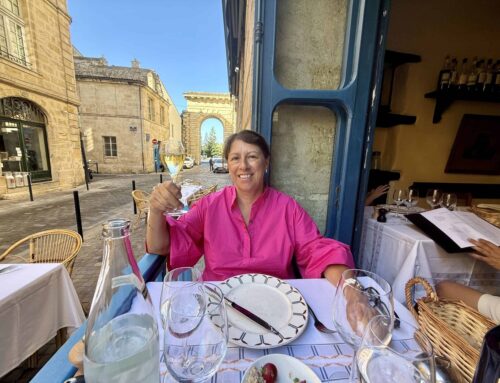
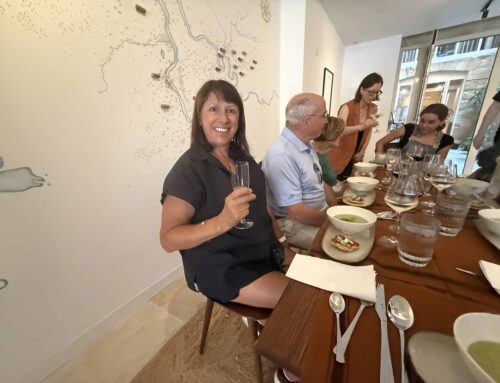
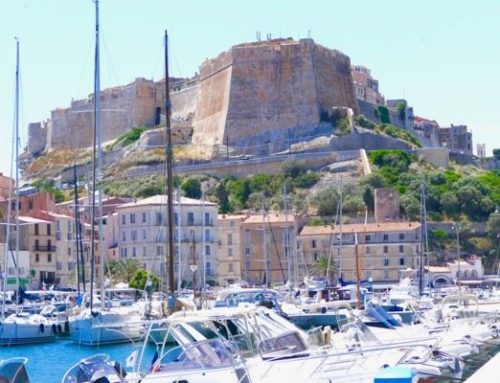
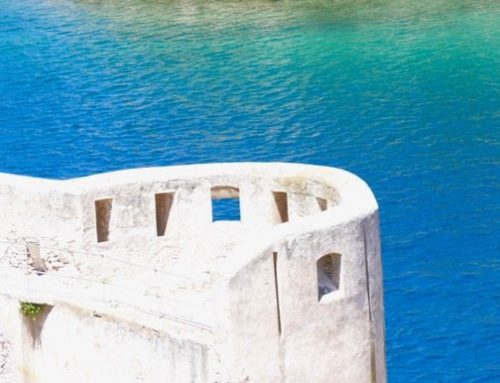
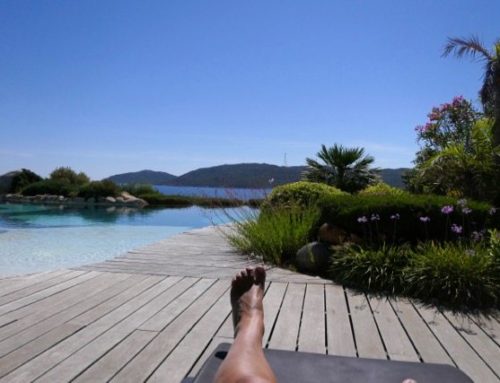
Leave A Comment